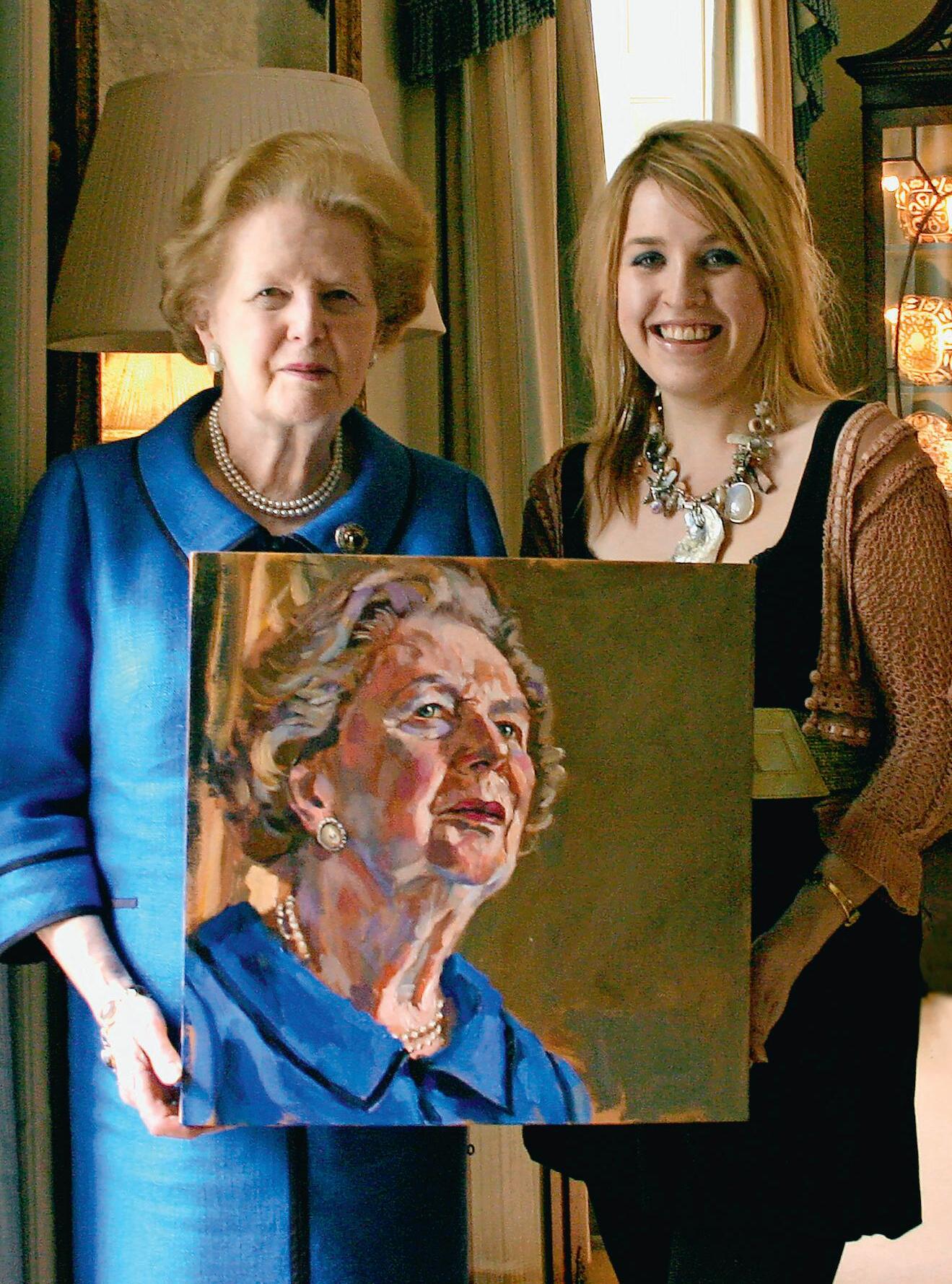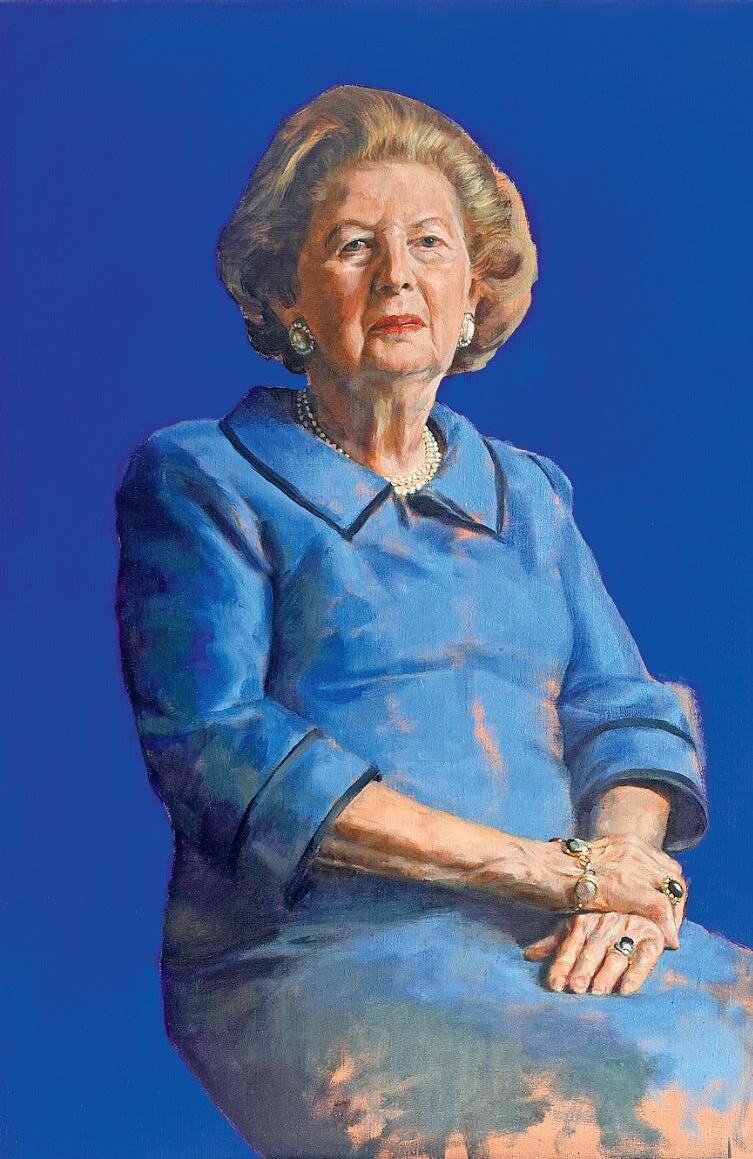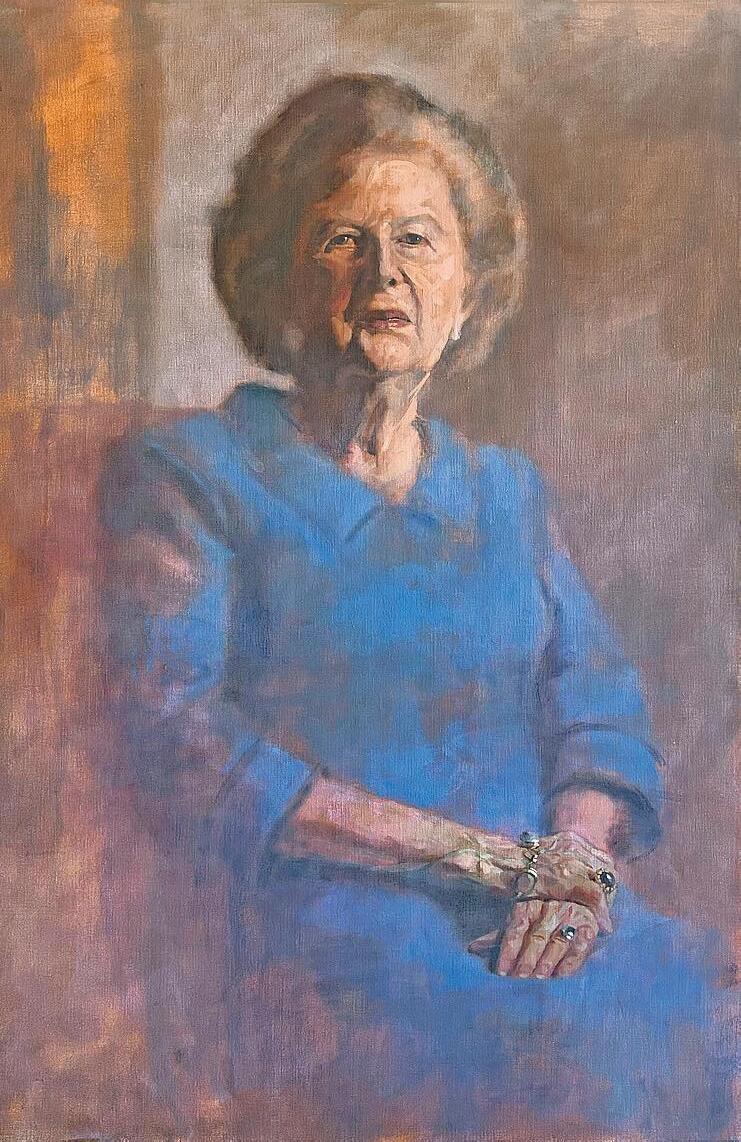July 2007. ‘Oh, you must paint Denis!’ Baroness Thatcher enthused at the beginning of our first sitting, as we settled next to each other on a chintzy, overstuffed sofa. Her lady-inwaiting gently clutched her hand. ‘Remember, Lady T — Denis died.’ A shadow crossed the older woman’s face. ‘Oh yes,’ she said softly, her voice tinged with sorrow.”
The portrait painter Lorna May Wadsworth, 45, is reading aloud from the diary that records the Alice in Wonderland period when, aged 27, she became the last artist to depict Britain’s first female prime minister from life.
Across five sittings at the politician’s home in Chester Square, Belgravia, the two shared tea, cake and — brilliantly, from the woman whose “handbaggings” were legendary — arm-candy tips.
“She admired my bag — an Yves Saint Laurent. I’d got it for £40 on eBay and proudly told her so. She exclaimed, ‘That’s a lot of money for a handbag!’”
At 82, Britain’s shoulderpadded Boudica was a woman changed. Rumours had been circulating since the late 1990s regarding the Iron Lady’s memory issues. But Wadsworth had not been primed about Thatcher’s health, leaving her to feel her way into the situation. The alteration was painful, poignant. The following year, dementia was confirmed and Thatcher died in 2013, aged 87. This month marks what would have been her 100th birthday, on October 13.
Wadsworth’s diary continues: “I was asked to keep her away from the windows, swathed as they were with acres of net to keep out the red dots of snipers. Any thought of revenge now seemed irrelevant, life itself having taken any retribution.”
In her east London studio, all scarlet lips and peroxide hair, Wadsworth describes that time. “She wasn’t batty like in the Meryl Streep film. She was like a huge galleon, stately and deliberate, her face remarkably unlined. Lips drawn with a deep, waxy colour, eyes as blue as pigment on a palette, glinting with resolve; a lacquered vision in starched blue linen and pearls. I remember having to fight the urge to curtsy, even though I
THATCHER AND ME
The
artist
Lorna May Wadsworth
painted the
last portrait of Britain’s first female prime minister. She tells Hannah Betts of their poignant sittings as the politician’s mind faded
don’t know how to curtsy. I had an uncanny sense that I was alone with living history.”
Their partnership came about after Wadsworth approached Thatcher, like so many of her sitters, by accosting her in public, then via a contact.
The result of the first four sittings was Baroness Thatcher, the 6ft x 6ft oil painting exhibited by the gallerist and broadcaster Philip Mould in 2014 between a Holbein portrait of Henry VIII and a Van Dyck self-portrait. Mould describes it as “the boldest formal life portrait of a prime minister ever painted in Britain”. (Wadsworth has also portrayed Tony Blair, Tony Benn and David Blunkett, among other luminaries.)
It sold to a private collector for £400,000 in 2014 and now looms large over the Conservative Party’s London headquarters. Viewed from below, “like the prow of a tanker”, it represented Wadsworth’s impression of Britain’s first female prime minister before meeting her, “growing up in Sheffield with Spitting Image and the poll tax riots”.
When the baroness viewed the image at their final sitting, she deemed it “very fierce”. Sensitive to injured vanity, Wadsworth offered to come up with another take. Besides, the pair had become friends; the painter’s view of her subject had altered. “As a child she was a bogeywoman, like the pantomime villains we would boo every Christmas. But over those weeks, we’d race around
together trying to find teapots, like children making a midnight feast, or I’d catch her trying to fill in the split silk on a chair with Biro. When I left, she’d blow kisses.”
At one point, she showed Wadsworth a book with a photograph on the cover of her and Ronald Reagan. “Ah, Ronnie!” she said, tracing the picture with her finger. “You see, I was in politics and he was in politics ... and so we had, er, some of the same views.”
After the sittings Wadsworth used to call and see her, bringing her mother’s Christmas cake. “I took a portfolio of paintings I’d done of Paris,” she remembers. “She wanted to buy one. And I was, like, ‘No, no, no, Lady T! I’ll paint you anything you like. If I could paint you anything in the whole world, what would it be?’ And she said, ‘I’d love a view of the Palace of Westminster from Parliament Square.’” Heartbreaking — and Wadsworth did it, as well.
The result of this second, more intimate moment, is another portrait, In Memoriam, painted between 2007 and 2015: resolute and magnificent. So much did her muse come to haunt Wadsworth that this final piece evolved into a sorority of subsequent oils: The Legacy Paintings, I to VII Like In Memoriam, they’re powerfully beautiful. Legacy I was painted with a teaspoon on wider-weave canvas “to recreate trying to remember something, but not being able to reach it, like a dream that eludes you on waking”. Legacy
II is the iteration that tends to be preferred by Thatcher fans: the sky blue-suited wonder woman surrounded by a hyper-femme, Andrexpink cloud.
There is the ironic enthusiast’s choice: Legacy IV, a 23-karat gold and Yves Klein blue Byzantine icon. The rusted Iron Lady of Legacy VII is the darkest, its brushwork glimmering with actual iron.
“I was thinking of Graham Sutherland’s lost late portrait of Churchill as a mortal man diminished by age,” its creator explains. “His wife famously had it consigned to a bonfire to protect his legacy.”
A Thatcher going up in flames: it reminds me of the celebratory bonfires in her Oxford alma mater the night she resigned in 1990, when offlicences ran dry of champagne.
Painted lady Margaret Thatcher and Lorna May Wadsworth with the painting Baroness Thatcher.
Above: Legacy IV, II, V and VI.
Below: In Memoriam
Still, today, there are divisive figures, and then there is I was asked to keep her away from windows and the red dots of snipers
Margaret Thatcher. Her Mary Poppinsesque Neil Simmons statue was notoriously decapitated at the Guildhall Art Gallery in 2002; while even the unassuming Keir Starmer banished her “unsettling” image from Downing Street, the dourly imperious Richard Stone commissioned by Gordon Brown in the late Noughties, recreating Falklands-era Thatcher. I once interviewed Helmut Newton and we discussed his marvellously feral photograph of the Tory leader in the National Portrait Gallery, teeth slightly evident with an S&M frisson. Feminists rejected her — as she rejected feminists — her fellow MP Glenda Jackson denying Thatcher’s femaleness on the latter’s death, dismissing her as “a woman — but not on my terms”. Her gender also proved a problem for artists struggling to reconcile power with femininity. Leonard Boden’s Disney-eyed Carlton Club rendition is chocolate-box.
June Mendoza’s 1983 and 1989 images boast a head-girl composure bordering on blankness. Rodrigo Moynihan’s 1983-5 depiction, which hangs in the National Portrait Gallery, has an uncharacteristic mousiness; while Henry Mee’s 1992 interpretation for the Parliamentary Art Collection feels borderline Spitting Image Nelson Shanks and Anne Mackintosh found favour with their sitter: poised, painterly approaches. Still, Wadsworth finds many previous attempts to represent the baroness
bizarrely “kitsch”, saying: “I’ve never had a sense that any of the portraits captured the impact this woman had on the landscape of history.” Thatcher remains controversial — for feminism, for the art world, for the world at large. Yet she saw us through what appeared to be the last gasp of the Cold War (now reheated), changing not one, but two political parties — and the nation with it. As we mark the centenary of the baroness’s birth, if anyone can help us to see this loved and loathed individual more clearly, it is Wadsworth. Behold, a fellow woman, fellow northerner and fellow middle-class prodigy, who also had to propel her genius forward with steel as well as charm. Theirs is a tale of an unlikely friendship at the beginning and end of careers — a story that should surely be immortalised in film. Meanwhile, we have In Memoriam and The Legacy Paintings. “Together, these works form a collective statement that attempts to reconcile public perceptions with the kind, dignified woman I came to love,” Wadsworth asserts. In a final high five to her subject, she adds: “I’ve decided to auction them rather than set the same price for each. I thought it would be an interesting exercise in free-market economics.” One senses her ally would approve.
An Iron Lady: The Legacy Paintings is exhibited at Noho Studios, London, Tue-Oct 12. The Legacy Paintings are auctioned online on Oct 19






